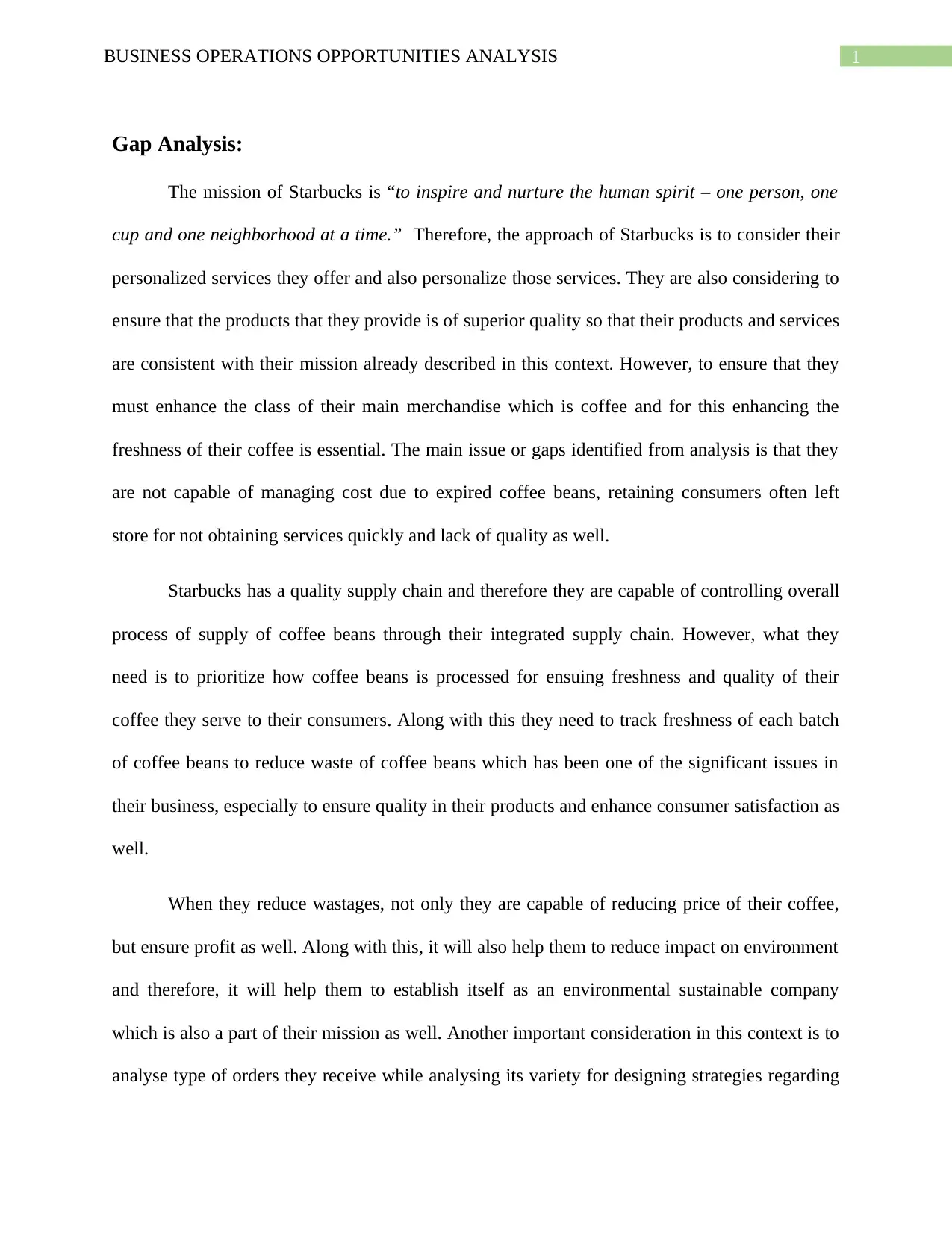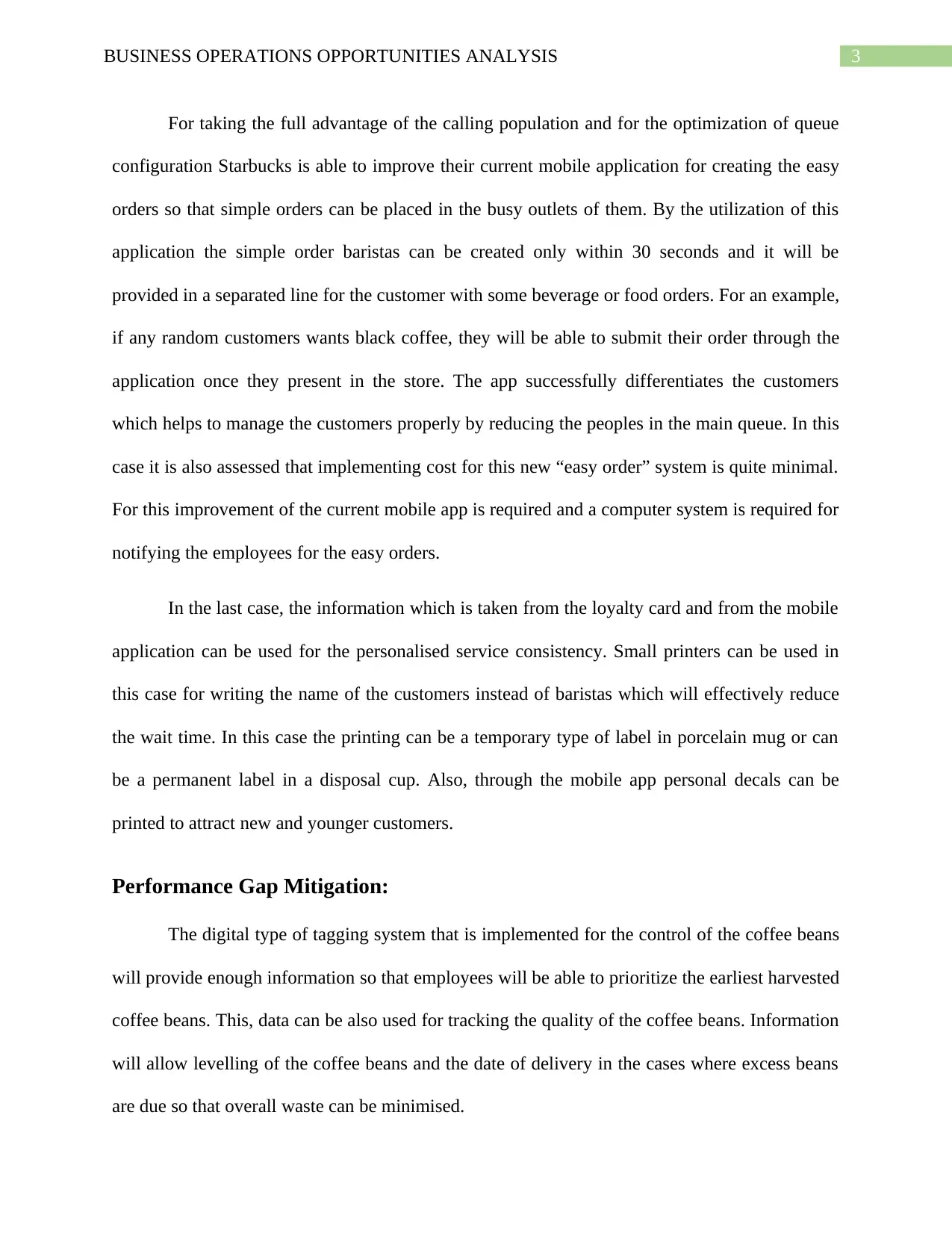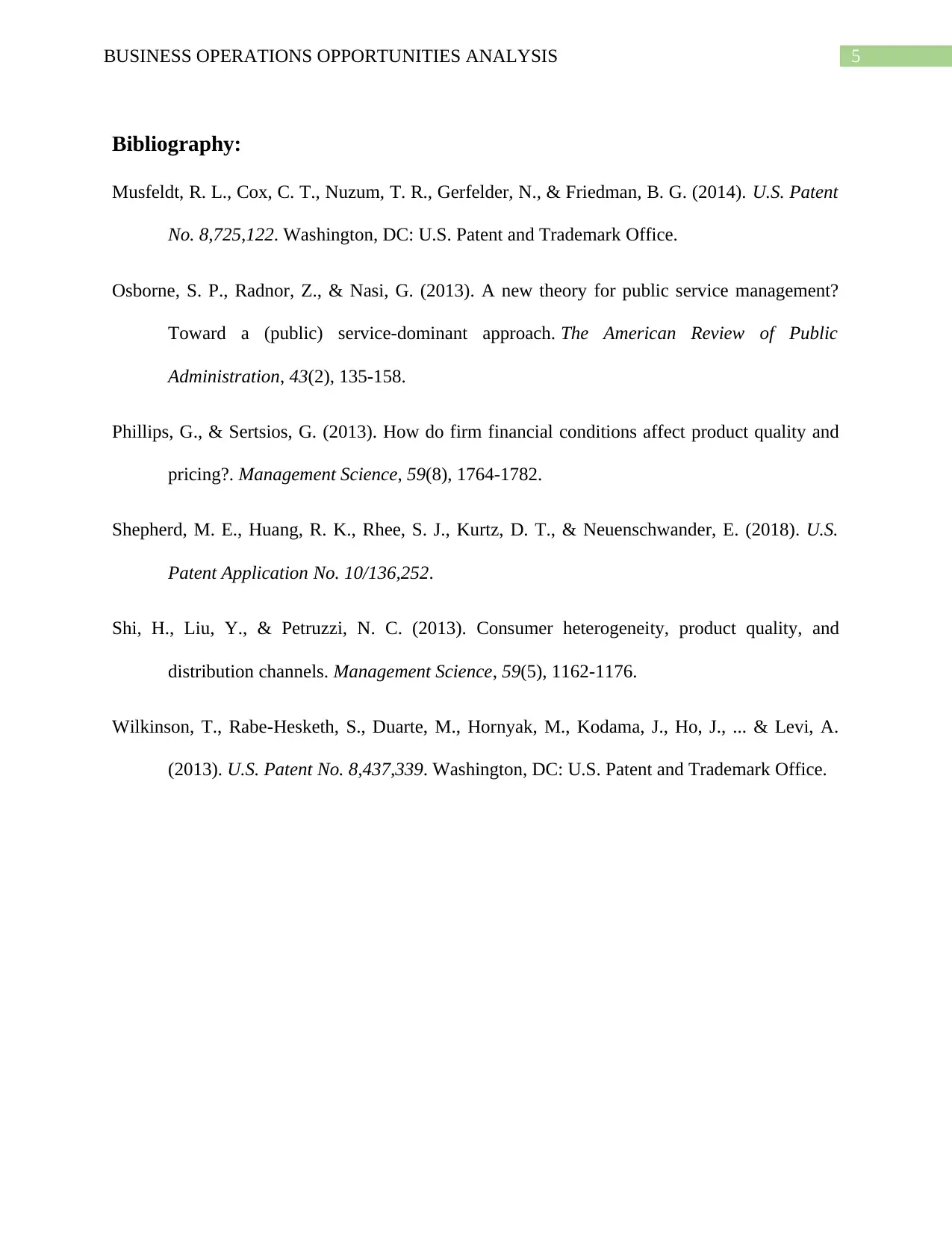Business Operations Opportunities Analysis: A Starbucks Case Study
VerifiedAdded on 2022/09/05
|6
|1364
|18
Report
AI Summary
This report provides a comprehensive analysis of Starbucks' business operations, identifying key areas for improvement and proposing strategic solutions. The analysis begins with a gap analysis, highlighting issues such as cost management challenges due to expired coffee beans, customer retention problems stemming from slow service, and quality concerns. The report then explores three specific opportunities for leveraging technology to address these issues: implementing a digital tagging system for coffee beans to manage freshness and reduce waste, introducing "priority lanes" integrated with the mobile application to expedite service, and utilizing small printers to personalize customer orders. The report emphasizes the importance of supply chain optimization, consumer behavior analysis, and personalized services. It also discusses how these technological solutions can be integrated with Starbucks' business objectives. Furthermore, the report provides a discussion on performance gap mitigation. Finally, the report concludes with a bibliography of relevant sources.

Running head: BUSINESS OPERATIONS OPPORTUNITIES ANALYSIS
Business Operations Opportunities Analysis
Name of the Student
Name of the University
Author Note
Business Operations Opportunities Analysis
Name of the Student
Name of the University
Author Note
Paraphrase This Document
Need a fresh take? Get an instant paraphrase of this document with our AI Paraphraser

1BUSINESS OPERATIONS OPPORTUNITIES ANALYSIS
Gap Analysis:
The mission of Starbucks is “to inspire and nurture the human spirit – one person, one
cup and one neighborhood at a time.” Therefore, the approach of Starbucks is to consider their
personalized services they offer and also personalize those services. They are also considering to
ensure that the products that they provide is of superior quality so that their products and services
are consistent with their mission already described in this context. However, to ensure that they
must enhance the class of their main merchandise which is coffee and for this enhancing the
freshness of their coffee is essential. The main issue or gaps identified from analysis is that they
are not capable of managing cost due to expired coffee beans, retaining consumers often left
store for not obtaining services quickly and lack of quality as well.
Starbucks has a quality supply chain and therefore they are capable of controlling overall
process of supply of coffee beans through their integrated supply chain. However, what they
need is to prioritize how coffee beans is processed for ensuing freshness and quality of their
coffee they serve to their consumers. Along with this they need to track freshness of each batch
of coffee beans to reduce waste of coffee beans which has been one of the significant issues in
their business, especially to ensure quality in their products and enhance consumer satisfaction as
well.
When they reduce wastages, not only they are capable of reducing price of their coffee,
but ensure profit as well. Along with this, it will also help them to reduce impact on environment
and therefore, it will help them to establish itself as an environmental sustainable company
which is also a part of their mission as well. Another important consideration in this context is to
analyse type of orders they receive while analysing its variety for designing strategies regarding
Gap Analysis:
The mission of Starbucks is “to inspire and nurture the human spirit – one person, one
cup and one neighborhood at a time.” Therefore, the approach of Starbucks is to consider their
personalized services they offer and also personalize those services. They are also considering to
ensure that the products that they provide is of superior quality so that their products and services
are consistent with their mission already described in this context. However, to ensure that they
must enhance the class of their main merchandise which is coffee and for this enhancing the
freshness of their coffee is essential. The main issue or gaps identified from analysis is that they
are not capable of managing cost due to expired coffee beans, retaining consumers often left
store for not obtaining services quickly and lack of quality as well.
Starbucks has a quality supply chain and therefore they are capable of controlling overall
process of supply of coffee beans through their integrated supply chain. However, what they
need is to prioritize how coffee beans is processed for ensuing freshness and quality of their
coffee they serve to their consumers. Along with this they need to track freshness of each batch
of coffee beans to reduce waste of coffee beans which has been one of the significant issues in
their business, especially to ensure quality in their products and enhance consumer satisfaction as
well.
When they reduce wastages, not only they are capable of reducing price of their coffee,
but ensure profit as well. Along with this, it will also help them to reduce impact on environment
and therefore, it will help them to establish itself as an environmental sustainable company
which is also a part of their mission as well. Another important consideration in this context is to
analyse type of orders they receive while analysing its variety for designing strategies regarding

2BUSINESS OPERATIONS OPPORTUNITIES ANALYSIS
how to ensure proper service to the consumers and reduce their waiting time at their outlets,
which is a significant issue of their service strategies. If they are capable of improve quality and
reduce consumer waiting time, not only it will enhance consumer satisfaction, but it will enhance
their business process as well.
Another important issue that Starbucks needs to analyse is how they might improve their
personalized services which is affecting their reputation and their business process as well.
Starbucks has this bad reputation that they do not care if they are correct in their spelling of their
customer name and whether they are pronouncing it correctly or not. These things are
significantly important while providing personalized services of which labelling beverage cups
with consumer name is an important aspect and therefore, ensuing quality in this service is
important as well.
Three specific opportunities for which technology is required provide context to reduce
costs, while improving service production, and also improving product quality. These include
coffee beans tagging from harvest to the process of grinding, implementing “priority lanes” that
are connected to the mobile application, especially at the outlets which are quite busy in nature,
and also printing names of the customer on cup.
For the minimization and wastages of the coffee beans interior digital system can be
used. In this case all of the coffee beans will be tagged and will have proper type of catalogue
information. This information will be including harvest date, origin, processing steps. Thorough
all of these processing earliest harvested coffee beans can be used before they got actually
expired.
how to ensure proper service to the consumers and reduce their waiting time at their outlets,
which is a significant issue of their service strategies. If they are capable of improve quality and
reduce consumer waiting time, not only it will enhance consumer satisfaction, but it will enhance
their business process as well.
Another important issue that Starbucks needs to analyse is how they might improve their
personalized services which is affecting their reputation and their business process as well.
Starbucks has this bad reputation that they do not care if they are correct in their spelling of their
customer name and whether they are pronouncing it correctly or not. These things are
significantly important while providing personalized services of which labelling beverage cups
with consumer name is an important aspect and therefore, ensuing quality in this service is
important as well.
Three specific opportunities for which technology is required provide context to reduce
costs, while improving service production, and also improving product quality. These include
coffee beans tagging from harvest to the process of grinding, implementing “priority lanes” that
are connected to the mobile application, especially at the outlets which are quite busy in nature,
and also printing names of the customer on cup.
For the minimization and wastages of the coffee beans interior digital system can be
used. In this case all of the coffee beans will be tagged and will have proper type of catalogue
information. This information will be including harvest date, origin, processing steps. Thorough
all of these processing earliest harvested coffee beans can be used before they got actually
expired.
⊘ This is a preview!⊘
Do you want full access?
Subscribe today to unlock all pages.

Trusted by 1+ million students worldwide

3BUSINESS OPERATIONS OPPORTUNITIES ANALYSIS
For taking the full advantage of the calling population and for the optimization of queue
configuration Starbucks is able to improve their current mobile application for creating the easy
orders so that simple orders can be placed in the busy outlets of them. By the utilization of this
application the simple order baristas can be created only within 30 seconds and it will be
provided in a separated line for the customer with some beverage or food orders. For an example,
if any random customers wants black coffee, they will be able to submit their order through the
application once they present in the store. The app successfully differentiates the customers
which helps to manage the customers properly by reducing the peoples in the main queue. In this
case it is also assessed that implementing cost for this new “easy order” system is quite minimal.
For this improvement of the current mobile app is required and a computer system is required for
notifying the employees for the easy orders.
In the last case, the information which is taken from the loyalty card and from the mobile
application can be used for the personalised service consistency. Small printers can be used in
this case for writing the name of the customers instead of baristas which will effectively reduce
the wait time. In this case the printing can be a temporary type of label in porcelain mug or can
be a permanent label in a disposal cup. Also, through the mobile app personal decals can be
printed to attract new and younger customers.
Performance Gap Mitigation:
The digital type of tagging system that is implemented for the control of the coffee beans
will provide enough information so that employees will be able to prioritize the earliest harvested
coffee beans. This, data can be also used for tracking the quality of the coffee beans. Information
will allow levelling of the coffee beans and the date of delivery in the cases where excess beans
are due so that overall waste can be minimised.
For taking the full advantage of the calling population and for the optimization of queue
configuration Starbucks is able to improve their current mobile application for creating the easy
orders so that simple orders can be placed in the busy outlets of them. By the utilization of this
application the simple order baristas can be created only within 30 seconds and it will be
provided in a separated line for the customer with some beverage or food orders. For an example,
if any random customers wants black coffee, they will be able to submit their order through the
application once they present in the store. The app successfully differentiates the customers
which helps to manage the customers properly by reducing the peoples in the main queue. In this
case it is also assessed that implementing cost for this new “easy order” system is quite minimal.
For this improvement of the current mobile app is required and a computer system is required for
notifying the employees for the easy orders.
In the last case, the information which is taken from the loyalty card and from the mobile
application can be used for the personalised service consistency. Small printers can be used in
this case for writing the name of the customers instead of baristas which will effectively reduce
the wait time. In this case the printing can be a temporary type of label in porcelain mug or can
be a permanent label in a disposal cup. Also, through the mobile app personal decals can be
printed to attract new and younger customers.
Performance Gap Mitigation:
The digital type of tagging system that is implemented for the control of the coffee beans
will provide enough information so that employees will be able to prioritize the earliest harvested
coffee beans. This, data can be also used for tracking the quality of the coffee beans. Information
will allow levelling of the coffee beans and the date of delivery in the cases where excess beans
are due so that overall waste can be minimised.
Paraphrase This Document
Need a fresh take? Get an instant paraphrase of this document with our AI Paraphraser

4BUSINESS OPERATIONS OPPORTUNITIES ANALYSIS
While using the starbucks app for the pay and order, organization can promote the
customers in service process participation. This app will also reduce the demand variability by
providing limited number of option that the customer can choose for the “easy order” queue.
Customers can also select default simple beverage through the app.
The implemented printer will also speed up the printing process which will improve the
service time. This technology can be easily included with the business strategic growth
objectives as various of language options for the non-english speaking customers.
While using the starbucks app for the pay and order, organization can promote the
customers in service process participation. This app will also reduce the demand variability by
providing limited number of option that the customer can choose for the “easy order” queue.
Customers can also select default simple beverage through the app.
The implemented printer will also speed up the printing process which will improve the
service time. This technology can be easily included with the business strategic growth
objectives as various of language options for the non-english speaking customers.

5BUSINESS OPERATIONS OPPORTUNITIES ANALYSIS
Bibliography:
Musfeldt, R. L., Cox, C. T., Nuzum, T. R., Gerfelder, N., & Friedman, B. G. (2014). U.S. Patent
No. 8,725,122. Washington, DC: U.S. Patent and Trademark Office.
Osborne, S. P., Radnor, Z., & Nasi, G. (2013). A new theory for public service management?
Toward a (public) service-dominant approach. The American Review of Public
Administration, 43(2), 135-158.
Phillips, G., & Sertsios, G. (2013). How do firm financial conditions affect product quality and
pricing?. Management Science, 59(8), 1764-1782.
Shepherd, M. E., Huang, R. K., Rhee, S. J., Kurtz, D. T., & Neuenschwander, E. (2018). U.S.
Patent Application No. 10/136,252.
Shi, H., Liu, Y., & Petruzzi, N. C. (2013). Consumer heterogeneity, product quality, and
distribution channels. Management Science, 59(5), 1162-1176.
Wilkinson, T., Rabe-Hesketh, S., Duarte, M., Hornyak, M., Kodama, J., Ho, J., ... & Levi, A.
(2013). U.S. Patent No. 8,437,339. Washington, DC: U.S. Patent and Trademark Office.
Bibliography:
Musfeldt, R. L., Cox, C. T., Nuzum, T. R., Gerfelder, N., & Friedman, B. G. (2014). U.S. Patent
No. 8,725,122. Washington, DC: U.S. Patent and Trademark Office.
Osborne, S. P., Radnor, Z., & Nasi, G. (2013). A new theory for public service management?
Toward a (public) service-dominant approach. The American Review of Public
Administration, 43(2), 135-158.
Phillips, G., & Sertsios, G. (2013). How do firm financial conditions affect product quality and
pricing?. Management Science, 59(8), 1764-1782.
Shepherd, M. E., Huang, R. K., Rhee, S. J., Kurtz, D. T., & Neuenschwander, E. (2018). U.S.
Patent Application No. 10/136,252.
Shi, H., Liu, Y., & Petruzzi, N. C. (2013). Consumer heterogeneity, product quality, and
distribution channels. Management Science, 59(5), 1162-1176.
Wilkinson, T., Rabe-Hesketh, S., Duarte, M., Hornyak, M., Kodama, J., Ho, J., ... & Levi, A.
(2013). U.S. Patent No. 8,437,339. Washington, DC: U.S. Patent and Trademark Office.
⊘ This is a preview!⊘
Do you want full access?
Subscribe today to unlock all pages.

Trusted by 1+ million students worldwide
1 out of 6
Related Documents
Your All-in-One AI-Powered Toolkit for Academic Success.
+13062052269
info@desklib.com
Available 24*7 on WhatsApp / Email
![[object Object]](/_next/static/media/star-bottom.7253800d.svg)
Unlock your academic potential
Copyright © 2020–2025 A2Z Services. All Rights Reserved. Developed and managed by ZUCOL.



